
|

|
|
Home Site Search Contact Us Subscribe
|
|
Amid Social & Economic Uncertainties, Major Public Art Welcomes & Elevates Tripling value of 1% for Art: Merging of art, architecture, and client mission By Gordon Huether November 12, 2020 The growth of large-scale art among airports, rail stations, office/mixed-use complexes and major institutional facilities is taking a renewed resurgence, despite tightening budgets. How are these projects, often fueled by 1% for Art mandates, ultimately successful for the project sponsor and the community? How can artists, architects, and sponsors work more collaboratively to get the best results – and hit multiple objectives?
We are in difficult times, and cost concerns may affect plans for site-specific art. Yet, if there was ever a time that art mattered, when art should transport you to a higher place, when art could unite us in inspiration, nature, and beauty, this is that time.
Organizations that hire designers want that impact; it’s up to us – artists, architects, engineers, builders, and consultants – working together to deliver it.
Our recent work for the Salt Lake City International Airport offers an example of a four-way approach to success.
Officials in Salt Lake City (SLC) decided art would be integral as they planned a much-needed upgrade by HOK for their 60-year-old facilities. The art components needed to “fit” both the scale of the 4 million square feet of improvements, but also to incorporate the goals of the city and the airport. Those goals included: branding “the new SLC,” as they call it, to publicize the advanced and health-conscious design of the project; support wayfinding through art landmarks; tell the story of Utah’s unique natural wonders and environmental consciousness; and elevate the traveler experience for an expected 20-30 million annual visitors.
Today’s owners and operators of buildings, airports, libraries, and the like want to connect with their constituents and their communities in every way, including through new facilities and spaces. They know that the structures they create, and the associated art, can help tell their story, illuminate their brand, and further their mission.
After working with hundreds of clients across several decades, I’ve come to see a few things that might offer insights in navigating that path, and were very much at work in Salt Lake City:
* Start early: There’s no better way to consider all the potential, the objectives, the challenges, and the eventual success without good planning. Architects and artists want to fully understand the client’s objectives, study the site and opportunities, create ideas – and then gain input to refine, or sometimes transform, those ideas. Multi-million-dollar investments in art can take years, though some projects with pre-determined aspects and guidance can fast track in months. The process for SLC started more than six years before the airport was complete, and included many hours of research and collaborative meetings with stakeholders and the design team in order to get a very personal and direct understanding of the opportunity. Starting early also allows for the artwork to be truly integrated into the “skin” of the building and the design, instead of being an afterthought or “plop-art” that is sometimes said of artworks with little connection to the site or project.
* Focus on mission and audience: It’s my strong opinion that the most successful large-scale public art is about the place, the mission, and the art itself – not the artist. The artist is the creative partner and conduit, but if a project is merely an artist’s personal vision or raison d'être, there’s more chance for a mis-fit or disappointment. Art installations, especially in transit centers, institutional settings, and public places, are for everyone – especially for the layperson.
For the new SLC, a prime objective from the start was to celebrate the natural beauty of Utah in a fully architecturally, integrated art program. The result is a series of installations, each telling a different story about Utah’s natural environment: “The Canyon“; “The Falls“; “The River Tunnel“; The “Column Plates and Benches”; and more. These works echo the iconic features attracting millions of visitors to Utah, and help market those offerings to millions of passers-by who might only be at SLC for flight connections.
* Think site-specific: Large-scale art, in my opinion, is indelibly linked to its site and surroundings. How will people experience the piece? What is the context, both physically as people come from various locations, and also the purpose and expectations they bring to their experience? What environmental framing is at play, whether light, surfaces, colors, textures, or the greater surroundings of buildings, nature, horizon? Consideration should also be taken of the day and night experiences, and changes of weather and seasons. An important aspect of “The Canyon,” a 360-foot-long installation along two walls of the main concourse, gives visitors an immersive experience of walking into one of Utah’s eons-old geological formations. To add dimension and variation, the lighting experience provides a sense of changing dawn/daytime/evening/nighttime scenes. Light also plays an important interactive role with “The Falls,” a massive suspended glass installation seven stories high that plays off of outdoor daylight at certain times of day, and interior lighting at others, to activate the sense of a moving waterfall.
Visitors also use the art installations as important wayfinding cues, such as identifying the main terminal housing “The Canyon” and when following the main escalators – which share vertical space with “The Falls” – up to the arrivals hall.
As I said during SLC’s first-phase opening, you don’t have to know anything about art to be moved, awed, and inspired when you walk through this airport. You don’t have to know anything about art to know that you are in Utah and can be inspired in this cathedral to transportation.
* Invest in teamwork: More and more large-scale art is performing the double- and triple-duty of merging with architectural design and client or community mission – a significant upside for project sponsors, if done right. For many large projects, the art investment is contractual, dating to percent-for-art requirements for U.S. Federal buildings of the 1930s, then slowly adopted by states, cities, and also private organizations. But project sponsors often struggle implementing these requirements when they are already hyper-vigilant with project costs, construction, and profitability. It’s actually a tremendous opportunity: art dollars can perform extra duty if the artist, architect, and project sponsor work together from early in the process.
The big
idea is to blur the lines between art and architecture and bring in elements of
the client’s mission. As noted by real estate industry news site Globestreet, the SLC art program is
“an airport branding tool, wayfinding aide, and tourism booster.” In our early meetings with SLC, the
then-airport director Maureen Riley stressed the need for an integrated art program
that accomplished all those goals, and one that would work seamlessly with
architecture firm HOK, builders, and consultants. Airport Director Bill Wyatt,
just named Director of the Year by Airport Experience Magazine, had
taken the reigns after Riley’s retirement and oversaw a complex,
multi-disciplinary approach that delivered on all fronts. Implementing successful large-scale art is an exciting and wonderful challenge. Project sponsors who embrace the process have an amazing opportunity to commission and create works that will inspire their constituents – and accomplish more of their own goals and mission as well.
Gordon Huether is a Napa, California-based artist specializing in large-scale, site-specific permanent art installations. He has been commissioned by universities, hospitals, civic buildings, airports, and private corporations throughout the world. Huether’s work is diverse in its range and its ability to communicate a story, going beyond the artistic goal of simply creating objects of beauty. With hundreds of works across a decades-long career, his largest commission to date, including seven large-scale integrated installations for the Salt Lake City International Airport, is completing in stages from 2020 to 2024. He also serves as consulting artist for SLC’s entire arts program. For more information, visit us at www.gordonhuether.com
|
(click on pictures to enlarge) 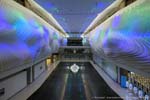 Stuart Ruckman All images: Installations at the Salt Lake City International Airport by Gordon Huether Studio; shown here: “The Canyon” 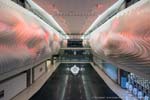 Stuart Ruckman “The Canyon” by Gordon Huether Studio 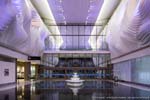 Stuart Ruckman “The Canyon” by Gordon Huether Studio 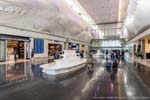 Stuart Ruckman “The Canyon,” with “The Benches” in foreground, by Gordon Huether Studio 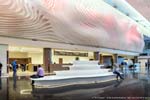 Stuart Ruckman “The Canyon,” with “The Benches” in foreground, by Gordon Huether Studio 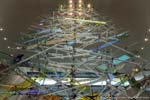 Stuart Ruckman “The Falls,” a 7-story-high x 12 feet deep suspended sculpture by Gordon Huether Studio 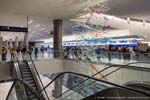 Stuart Ruckman “The Falls” by Gordon Huether Studio 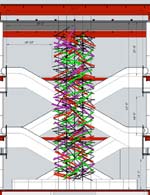 Gordon Huether Studio Elevation for “The Falls” 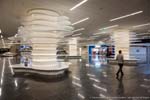 Stuart Ruckman “Column Plates” by Gordon Huether Studio |
© 2020 ArchNewsNow.com